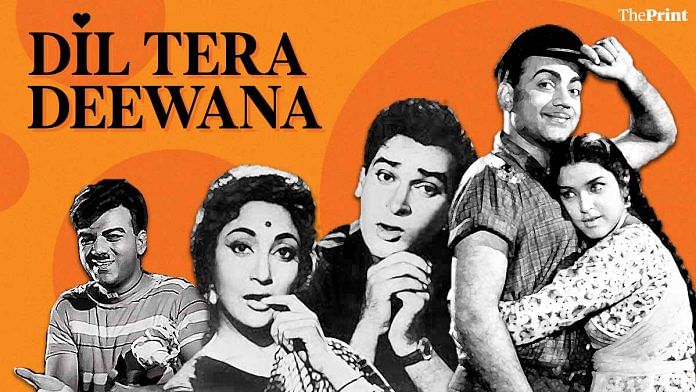It’s hard to be the star of a movie when Shammi Kapoor is also in it. His loose-limbed energy, languid, romantic eyes and roguishly, lazily charming smile all tell the viewer that he was born to be a star, and if you’re his co-actor, you will be overshadowed. But Mahmood was different.
Most people now know of and slot Mahmood as a comedian, but when he was at his peak in the 1960s and ’70s, many of the leading actors of the day were nervous about working with him, for fear of being overshadowed. Some even refused to sign a film if they knew he was in it, and it is believed he even commanded a higher fee than many lead stars.
When Mahmood died, on 23 July 2004, his Dil Tera Deewana co-actor, Shammi Kapoor, called him the “best comedian we had that time. He was a very very versatile actor we had our time.” He added that Dil Tera Deewana was Mahmood’s best performance. And watching it, one can instantly see why. Despite having to play off Shammi’s larger-than-life persona, it is actually Mahmood who carries the film on his shoulders. His scene-stealing facial expressions and the voices he could do are a class act in comedy and they are what make the film.
In the week of the legendary comedian’s death anniversary, ThePrint rewinds to Dil Tera Deewana.
Also read: With Bobby, Rishi Kapoor and Dimple Kapadia set the bar for young love in Bollywood
A comedy of identities
Directed by B.R. Panthalu, the 1962 comedy follows the story of Mohan (Shammi Kapoor), a wayward, spoilt young man whose wealthy father decides to send him off to his old friend, a retired jailor named Daya Ram, for a dose of discipline. Mohan begs his best friend, Anokhe (Mahmood) to go in his place and pretend to be him. It’s a win-win situation, he says, because Anokhe is a poor orphan who has never had creature comforts, while Mohan craves Anokhe’s independence from having to answer to any parental figure.
Of course, these days one would imagine that Daya Ram would be on Facebook and might do a bit of spying on his friend’s son, but given that it’s the ’60s, of course Daya Ram and his daughter Malti (Shubha Khote) have no idea what their expected house guest looks like, so the plan works — up to a point. Anokhe moves in with them and, of course, he and Malti fall in love. Except, well, she thinks he’s Mohan.
Meanwhile, Mohan has developed a crush on Meena, a young dance teacher who lives next door to where he’s shacking up aimlessly. She and her blind father have only each other, and a parallel story involves their lecherous, creepy driver Ganpat (Pran), whom they fire and replace with Mohan. Meena reciprocates Mohan’s feelings, but, like Malti, doesn’t know her lover’s real identity.
It’s an obvious recipe for disaster and a gold mine of comedy. The part when Mohan’s parents come to visit him at Daya Ram’s house, in particular, is a scream, with both Mohan and Fake Mohan convincingly pulling the wool over the parents’ eyes.
And then, things come to ahead with an Anokhe look-alike, a cycle-rickshaw driver named Sohan (also played by Mahmood), who gets thrown into the mix. What follows is a madcap chase to find out who the real Mohan is. All, of course, with some immensely hummable tunes, as expected in a Shammi Kapoor movie.
Also read: Mr India may have been played by Anil Kapoor but Sridevi was the best thing about it
Shammi got the songs but it’s Mahmood’s movie all the way
The movie is billed as a comedy, and it is extremely funny, but it is also an examination (albeit lighthearted) of class disparities. The role reversal between Mohan and Anokhe is not only mined for comic effect, but shows Mohan experiencing, in some ways, how the other side lives.
In fact, Mahmood as Fake Mohan gets far less screen time, and while that may have been because Shammi was Shammi, it also served to show that Mohan was the one who needed to learn that there is a whole other world that doesn’t throw around their father’s money, that doesn’t have their mother wrapped around their little finger, that doesn’t even have all the ingredients to make a cup of tea in the mornings. And with the entry of Sohan, we see another layer of that economic disparity, even though that entire portion is dealt with via inane slapstick.
Mahmood’s double role is a standout for the way he is able to play both characters so differently. His felicity with vocals, his facial twitches and even his movements are careful, yet appear effortless.
Even though he began working in films in the 1940s, it was with Dil Tera Deewana that the comic actor finally became a bona fide star, and the proof of that is that even today, while watching it, one wants more of his scenes and less of Shammi. It didn’t even matter that Shammi and Mala Sinha got all the songs, barring one, Dhadakne Lagta Hai, in which Mahmood matches Shammi step for step and expression for expression — dressed as a woman. That’s how good he was.
Also read: Nasir Husain’s Hum Kisise Kum Naheen is all about the music




You cant take away shammi’s credit…the movie itself sold out to distributors in the name of shammi …he was class apart nd above mehmood …though i liked couple of mehmood’s scenes…
Great movie, I have seen it same where in 1980 and really enjoyed much more then it told here, great comedy and super hit songs,
Nice article.
A third rate analysis…. more of a summation of a story rather than any review of the creative or technical aspects of the movie. Nonsensical Blabber!